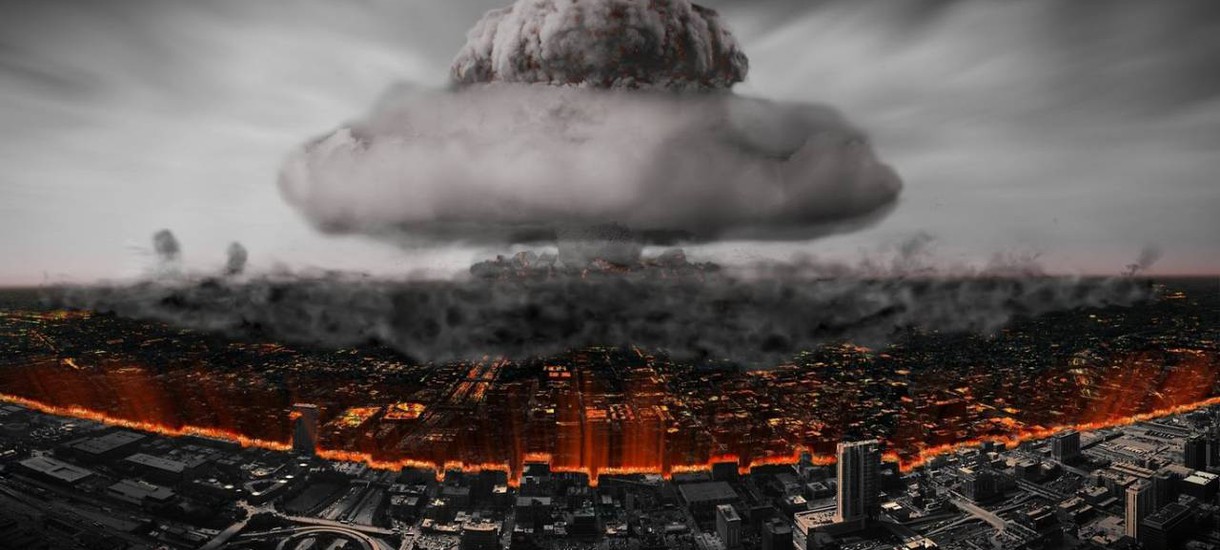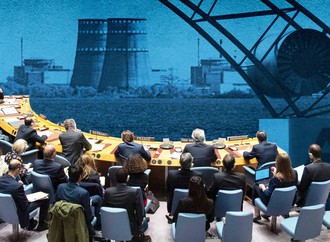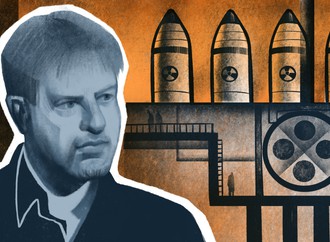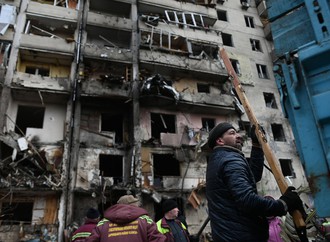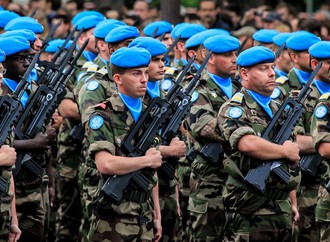Recently, the American magazine “Vox” has published a lengthy article about the military conflict possible scenarios between the US and Russia. Interviewing a number of both Russian and Western military experts, the publication came up to a very disappointing conclusion – the conflict node will keep on lasting, which means that at some point the sides will risk to resort to “the last argument.” The world has started talking about the nuclear weapons.
For the first time since the end of the Cold War, ones talk about the nuclear confrontation not hypothetically, but in terms of real politics. And even if at the beginning of the “Ukrainian crisis” such warnings might have seem alarmist, today it no longer seems to be something fantastic.“ The nuclear winter” – the destruction of the planet’s life by strategic nuclear strikes, I mean, “nuclear autumn” – a local disaster from the use of the tactical strikes – it is still considered to be madness. On the other hand, two years ago, it was also difficult to believe in a bloody war in Europe, but during this time the threshold of madness has grown considerably.
Currently, the “nuclear” problem is not in the medical madness of world leaders. It is located in a field of the adventurous military-political strategies and doctrines of both parties, which, under the increasing intensity of the conflict, are able to force the enemy to click on the “red button.”
“Radioactive ashes”
Sunday evening, on March 16th, 2014, on the “Russia-1” TV channel, the final transmission with the TV presenter, Dmitry Kiseliov, has come out. One of the phrases, uttered that evening, has immediately become the talk of the town: “Russia is the only country in the world, able to transform the US into the nuclear ashes.” Thus, the presenter tried to explain why Barack Obama’s head has covered with gray. In other words, white hair covered the President’s head after the official governmental body “Russian newspaper” published a detailed article about the system of the guaranteed nuclear retribution – the system of “perimeter”, which the United States have called the “dead hand.” “A coincidence? I do not think so” – said Kiseliov in his manner.
The true coincidence was not in the grey temples of the American leader, but in that Kiseliov’s nuclear glorification has been announced just the day, the Crimea referendum on the future that awaits the Peninsula ended. Exactly two days later, Putin will perform with his historic “Crimean speech”, where he will state: “Russia has found itself at the line, from which it could no longer retreat.” At that moment the official Kremlin didn’t recognize the key role of its military forces on the peninsula – the sincere confession will appear later.
But the words, uttered by Putin in a year in the “Crimea. The way home” movie, that throughout the whole Crimean Operation, the Russian Federation armed forces were ready to bring atomic weapons on alert, will become a true revelation. Some observers even dared to suggest that the whole movie has been filmed just for the announcement of the Russian president’s nearly sensational words, after which the statements about “nuclear ashes” during the referendum stopped looking only like Kiseliov’s rhetorical technique.
Cinematic Putin’s statement is not his only nuclear passage over the past year and a half. For instance, during a visit to Seliger camp, one of the students asked the president whether Russia could find itself at the centre of a new global confrontation.
“Let me remind you that Russia is one of the largest nuclear powers in the world. It’s not just words, it is reality. Moreover, we are strengthening our nuclear deterrence capability,” – said Putin.
Moscow’s doctrine and the new missiles
The Russian leader has every reason for such applications. Today Russia retains global leadership by the number of nuclear arsenal. Moreover, Russia remains one of the only two states that have full “nuclear triad” – the strategic aircraft, intercontinental ballistic missiles and nuclear submarines.
Inherited from the Soviet Union the “nuclear shield” – this is a thing. Which, along with the generous deposits of gas and oil, has been and remains the key to the sovereignty of the Russian Federation. According to Immanuel Wallerstein, in the modern world system, there is no more than twelve states, able to carry out their own independent foreign policy. Russia is included in their number, not least because of the round the clock its strategic rocket forces’ alert.
Of course, young Russian imperialism can’t fully compete with its older “Western partners”, including the richest country in the world, the US, which has the broadest access to the world markets, the best defence industry, possesses a printing press for the issue of the dollar, and over the aircraft carriers of which the sun never sets.
The range of influence instruments, which Russia owns in the current conflict, is extremely limited. That is why, the loud mentions of the “red button” have appeared so quickly. And it’s not only limited to the statements. Thus, at the end of December 2014, Vladimir Putin has signed a new version of the Russian military doctrine, in which the Kremlin has once again reminded of its right to “push the button.”
“The Russian Federation reserves the right to use nuclear weapons in response to the use against it and (or) its allies of nuclear and other weapons of mass destruction, as well as in case of aggression against the Russian Federation with the use of conventional weapons, when there is an existential threat to the State. The decision to use the nuclear weapons is being adopted by the President of the Russian Federation” – the document states.
Analysing this diplomatic paper, the “Vox” magazine stresses that the “Judgment Day” lath fell significantly. Specifically, compared with the doctrine of the Soviet Union, which included the possibility of using the nuclear shield only as a reaction for the nuclear bombing of the country. 30 years ago, the conventional weapons have not been yet discussed, as well as the vague term “existential threat.” “None of the Soviet leaders accepted the idea that the nuclear war can be won,” – the publication states.
Fig. 2. The Russian intercontinental ballistic ground based missiles’ modernization plan until 2024. Some of the nuclear mines will be closed, the missile forces on the mobile launchers are going to be increased.
In March 2015, Russia has conducted the most extensive study of the Strategic Missile Forces (SMF) in its history. 30 missile regiments have been involved in the training at the vast territory from the Tver to the Irkutsk region.
Earlier, the Chief of General Staff, Valery Gerasimov, stated that Russia’s nuclear modernization of the country will be a priority of the Ministry of Defence in 2015. In general, as the “The National Interest” magazine states, the political leadership of the country aims to modernize all three elements of the nuclear triad by the end of 2021.
Besides, in the end of 2013, when the Ukrainian events were only gaining rotation, Russia has decided to place on its western borders – in the Kaliningrad exclave – “Iskander” type missiles. The first ones among the NATO member states to write about the appearance of the “Iskanders” on the “island” were the German media, and this information has immediately caused concern in the US State Department. In its turn, Russia didn’t deny the deployment of mobile launchers, explaining that this is not contrary to the international treaties.
The assumptions about the Russian tactical nuclear weapons’ placement in the Crimea have repeatedly sounded in the Western press. However, this information has not been confirmed. In the response, the Russian Foreign Ministry issued a rather tough tone statement, which stated that Russia has every right to deploy nuclear weapons throughout the country. Russian Defense Ministry announced its intention to move ten Tu-22M3 missiles to the peninsula, however, the transportation of nuclear missiles was not mentioned.
The “New York Times” publication in December 2014 caused another wave of concern. Citing the sources in the highest offices of the US, the publication claimed that the US government has information about the trial of medium-range missiles in Russia. Such missiles with a range of 500 to 5500 kilometres are prohibited under the INF Treaty, signed in 1987 between Ronald Reagan and Mikhail Gorbachev. Pentagon confirmed this information: “Yes, we know, we are concerned and run the negotiations.”
However, Russian diplomats have called these charges baseless and started demanding facts. The foreign ministry of Russia viewed it as a unilateral offer to sprinkle the head with ashes and hinted at the similarities in accusations with the history of the notorious “chemical weapons of Saddam Hussein.”
Fig. 3. The potential radius range of Russian nuclear missiles in Europe. 500 km – the range of “Iskander-M” complexes, 2000 kilometres – according to unconfirmed reports, is the maximum flight range of Russian medium-range missiles. Infographics by Stratfor.
The latter considerable resentment of the West caused the July speech of Vladimir Putin that the Russian Army in 2015 will have more than 40 new intercontinental ballistic missiles in its armament. According to him, the rockets will be able to overcome any advanced anti-missile system. The sharp reaction of NATO came immediately.
“If someone threatens any of our territories, we, therefore, will have to appropriately target our armed forces, power, modern facilities at the territories, from which comes the threat,” – stated NATO General Secretary Jens Stoltenberg in response.
Out of all these statements and steps, there may feel a fairly strong military spirit, if not to say more. The degree of this determination in different societies and communities is evaluated differently – the range of these estimates is ranging from unconditional approval of the defense strategy to the nuclear blackmail accusations.
But the important point is that the NATO countries, particularly the United States, show a lesser persistency in militarization and nuclear race. Most of Russia’s actions in the nuclear field, as the White House keeps repeating, is a response to the unilateral Alliance steps. And there are reasons for such assessments.
The echoes of the Cold War
The fact is that the valid during the Cold War nuclear parity was violated.
After the dramatic events of the Caribbean crisis, when the world was standing on the brink of existence, both sides – the USSR, and the US – have concluded that the accumulated nuclear arsenals are enough to cause catastrophic consequences and that everyone will fail to win in the full-scale nuclear war. From that point forward, the terms “mutual assured destruction” and “nuclear deterrence” appeared – the latter principle has later formed the basis of the opponents’ military doctrines, and during the rest of the twentieth century has almost closed the doors upon the crisis, similar to the one in 1962. The so-called nuclear parity has been established.
Without a doubt, the temptation to get ahead of the game in the arms race didn’t disappear, especially in the US, for whom it was difficult to come to terms with the loss of the sole nuclear dominance. Thus, in 1973, US Secretary of Defence, James Schlesinger, suggested a new strategy of the “blinding nuclear attack”, according to which it was expected to cause a lightning strike on Soviet command centre for preventing the reverse counterattack. To this end, the active deployment of tactical nuclear intermediate range weapons, capable of hitting targets in the European part of the Soviet Union, began in the Western Europe.
In response to the new dangers, the Union has created the same, cited by Dmitry Kiseliov, “Perimeter” system. This system was designed to neutralize the threat of the “blinding strike” and to automatically attack the enemy in case of the nuclear aggression on the country, for which it earned the “Doomsday machine” nickname. The “Perimeter” system was being put on combat duty in 1985.
The other significant tension between Washington and Moscow occurred in 1980. At that time, as the most likely scenario for the use of nuclear weapons, the both sides considered possible the war in Europe. This is the so-called concept of the “limited nuclear war”, when the tactical nuclear weapons are being used against groups of enemy troops and military facilities, to ensure superiority on the battlefield. Roughly speaking, to give the opponent a fatal strike, to hurt him with the expectation that it wıll not come to the recompense for strategic missiles.
Thus, to protect its western borders, in 1976, the European part of the USSR deployed the new medium-range missiles “Pioneer”. These rockets quickly became famous under the name “Storm of the Europe” or “euromissiles.” Targeted at NATO countries, “Pioneers” were intended to destroy, if necessary, the military infrastructure of NATO in Western Europe and to prevent the landing of American troops. Instead, in 1983, the US deployed its medium-range missiles “Pershing-2” on the territory of Germany, Great Britain, of Denmark, Belgium, and Italy in 5-7 minutes from approaching the targets on the USSR territory. During these years, the word “Pershing” was on the tip of each apprentice’s tongue.
Fig. 5. The frequency of references to the phrase “nuclear war” in English literature from 1950 to 2008, according to the “Google Ngram” service schedule. The peak falls on 1985. Russophone graph exactly repeats this picture.
The “euromissile” competitions have made the 80’s the hottest nuclear phase of the Cold War. NATO military exercises in Europe forced the Soviet military leaders to expect that under the guise of training there will be a strike over the Soviet Union. A similar situation occurred, when the study was carried out by the Soviet troops. Yuri Andropov promised to promote “Pioneers” to the GDR territories and to bring the nuclear submarines to the shores of America, and Reagan, in his turn, announced the construction of a space missile defence system, which threatened with the start of the so-called “Star Wars” – arms race in the outer space.
The “nuclear winter” fear has imprinted in the culture of the time. Sting wrote the song “Russians”, in which he expressed the hope that “I hope that the Russians love their children too”. The nuclear war scenario is being played out in the James Cameron’s cult movie “The Terminator” (1984).
“Dear Mr Andropov, my name is Samantha Smith. I am ten. Congratulations on your new job. I am very concerned about the nuclear war start between Russia and the United States. Are you going to vote for the beginning of the war or not?” –
this US schoolgirl’s letter remember probably all the contemporaries of the events, as well as her Soviet Union tour at the General Secretary’s personal invitation.
The signing of the 1987’s Washington Treaty has put the end to the tension – the Treaty on the of intermediate and short range missiles’ elimination (ISRM). During the next years, the “Pioneers” and “Pershing” have been destroyed. In 1991, the Soviet Union and the US have signed yet another agreement, which dealt with the reduction of the strategic purpose nuclear arsenals. Although, at that time, it didn’t have such a crucial meaning, as a few years ago, because one of the parties left the game. Both the Warsaw Pact and the Soviet Union stopped existing.
Fig. 6. The dynamics of the USA and the Soviet Union (Russia) nuclear arsenals’ extendıng and reduction from 1949 to 2012.
With the socialist bloc collapse, the former parity evaporated, the system of unipolar dominance of the United States – from now on the “world policeman” – has been established in the world.
Yeltsin’s Russia was in a coma of primitive capital accumulation with the associated criminality, the first Chechnya, with the theft of state property, shock therapy, and people’s poverty. The nuclear shield began to decline, although was being maintained at the minimum required level.
On the other hand, even the United States, who at least wanted the nuclear facilities to fall into the hands of the first available adventurers, were not interested in the deepening of Russian instability. Guided by the similar considerations, the US insisted on the rejection from the nuclear arsenal, which has been inherited by the new regimes of Ukraine, Belarus, and Kazakhstan. Without access to the “red button”, of course, these regimes wouldn’t be able to use the deadly missiles, but would be able to purely theoretically destroy nerves, for example, through the sale of missiles and warheads to other countries.
In the 90’s it seemed that the systems’ race has finished. Francis Fukuyama has confidently blown the trumpets all over the world about the “end of history.” The remains of the Soviet troops got away from the Eastern Europe, Russia and the United States continued the unprecedented reductions of nuclear arsenals. However, who at least wanted to hit nuclear facilities at first-hand hast slain adventurers the US did not intend to stop at these conquered strategic heights.
The hawk of peace
The foundations of the modern conflict were laid during the last years of Clinton’s leadership. In 1999, the NATO forces carried out a military operation against the Kremlin’s last ally in Europe – Yugoslavia. In the same year, NATO’s eastward expansion began, former Soviet bloc countries – Hungary, Poland and the Czech Republic – joined the alliance.
Known for his militant ardor, the Republican George W. Bush, continued the policy of expansion with even stronger pressure. In 2004 NATO is being replenished with new members: Bulgaria, Romania, Slovakia, Slovenia and the Baltic states – Latvia, Lithuania, and Estonia. That same year, not without the blessing of the US, a pro-Western regime is being established in Ukraine. Alliance went straight to the doorstep of Russia, which, of course, disturbed Moscow, where now on the throne sat Vladimir Putin.
In 2002, Bush administration introduces significant amendments into the US nuclear doctrine. Now, it eliminates not only the possibility of parity, but also provides the use of military force, when other states are attempting to achieve it.
“Our armed forces will be sufficiently equipped to persuade the potential adversaries not to increase their arms, hoping to beat or to match the power of the United States,” – states the new version of the National Security Strategy.
In support for its intentions, the same year the US comes out of the Treaty on missile defense, concluded in 1972 with the purpose of slowing down the arms race. The Bush administration didn’t have any obvious reasons for this besides following the new military doctrine.
At a first glance, the deployment of NMD system is an exceptional measure of defense. In reality, the strengthening of the NMD system means the of any parity gaining. According to the US policy critics, it will give Americans a chance to strike a proactive nuclear attack on Russia or to perform an intervention and, after that, to minimize the losses from the retaliation of the same “Perimeter” system and other missile units.
The US NMD system elements have been placed in a number of European countries, also, their deployment is planned in close proximity to the Russian border – in Poland and Romania. The Alliance does not tire to repeat that the NMD in Eastern Europe are not directed against Russian missiles, which can easily overcome this barrier, but against the Iranian missiles. Russia holds the opposite point of view.
“They would be better to think of another – those Poland and Romania. Locating NMD elements, missile launchers that really aimed at our strategic nuclear forces – that’s a problem for them. They automatically become our goals” – recently the deputy of the RF Security Council Secretary, Evgeny Lukiyanov has stated.
Another US step against the parity establishment was made in May 2012, after the following NATO summit. The so-called “Chicago triad”, which provides the integration of nuclear, anti-missile and ordinary weapons of all Alliance members, has been formed. Thus, the merge of mılıtary forces, which didn’t exist even during the Cold War, happened. Currently, the US nuclear weapons are operatıng in a strong strategic alliance with the forces of countries such as France and Britain.
Finally, there is a purely geographical argument for the not very peaceful US plans. None of the countries, except the United States keeps its nuclear weapons on the territory of third countries. Russia or China can only come close to the borders of a potential enemy wıth its submarines. There is no military base of potential opponents in the close proximity to the United States – eıther wıth the nuclear weapons or without. Not to mention how the fenced off from the rest of the world by two oceans the North America ıs secured from the risks of ground operations.
Fig. 9. The US nuclear weapons’ location in Western Europe. There should also be added the arsenals of France and the UK as a result of the Chicago triad creation
Even after the Soviet Union had removed its missiles from the Eastern Europe, the US strategic bombers continued to bear alert at Belgium, the Netherlands, Italy, Germany and Turkey airfields – officially non-nuclear countries. Moreover, in the case of the martial law introduction, the atomic weapons will be handed in to use of these NATO members, which violates the Treaty on the Non-Proliferation of Nuclear Weapons. Recently, the Russian Foreign Ministry accused NATO of Polish pilots’ training on the use of nuclear weapons, which draws new nuclear-free countries in the nuclear race.
A glance at the map is enough to see how the military (including nuclear) ring around Russia is shrinking year by year. It would be strange if it did not cause irritation of the Kremlin. Ukraine has become a point of no return. “Nowhere to retreat” – as Putin said in the Crimean speech.
Russia’s reaction, as everyone knows, was more than tough. The first annexation of territories in Europe since the fall of the Berlin Wall; creation of controlled chaos in the Donbass; the first European war in the twenty first century; fierce propagandist onslaught; full inclusion into the arms race and tapping the fingers near its own “buttons.” Why was the response this way, and not otherwise? The moral evaluation in this case is the subject of faith. As a bottom line, Russia acts this way just because its tools of influence on “Western partners” are very limited.
It is unlikely that people of Kiev, who cut sandwiches in the House of Trade Unions, predicted that they would become the catalyst for an unprecedented post-Cold War global nuclear tensions. It is not exactly known whether the former Ukrainian opposition and the exalted Ukrainian nationalists have overseen such a scenario. But one cannot turn the history back.
“Our MIG’s will land in Riga”
The “Vox” magazine in its publication identifies two main scenarios, in which the mines of nuclear weapons might open. The first is the military conflict in the Baltic countries. Numerical and at the same time discriminated Russian-speaking minority of Latvia and Estonia has for a long been glancing with hope toward the historical homeland. The publication suggests that Russia can use the script, played in the Donbas. When in Russian speakers’ areas, namely in Narva, the visiting volunteers will raise the white-blue-red tricolor.
“NATO is simply not built to cope with this kind of crisis. The circular defense of the organization, after all, is based on the assumption that the concept of war is black and white; that the country is either in the state of war or not. Its charter was created at a time, when wars were not so different, as it is today, with their many shades of gray” – states the newspaper.
Fig. 10. Estonia. The portrait of Russian President Vladimir Putin on the anvil of Friendship Bridge in Tartu with the caption: “Uncle Vova will bring everything in order.”
This begs the question. If a civil conflict in Baltics flares without outside intervention, will the NATO members enter the war? If not, it will mean the collapse of the North Atlantic Alliance. It will prove its incapacity. And one part of military expert’s respondents suggests that this development of events is a tremendous temptation for Vladimir Putin.
And what will happen if they will enter? This would mean a full-blown conflict between Russia and NATO. And, accordingly, the high risk of the nuclear batons’ use.
The second scenario is a big war in Ukraine. Such a scenario may trigger the US providing Ukraine with the lethal weapons. Of course, only if Ukraine’s leadership will decided on a “final” military solution to the conflict in the Donbass. In August 2014, during a massive Ukrainian Armed Forces’ on-comıng to the rebel positions, Russia has demonstrated that it will not allow the military defeat of the latter and, if necessary, will provide them with the necessary assistance so they could survive and go on the offensive.
In March, the US analytical agency “Stratfor”, which is sometimes called the “shady CIA”, has simulated the “Great War” situation in Ukraine. In particular, the (counter) attack of separatist forces with the Russian army connecting, and the direct intervention of the NATO air forces in the conflict, using fighters and bombers. If this theater of war burns with the new force, one will speak about the nuclear potentials speak as substantive as only possible.
Nuclear war sociology
A separate issue is the attitude of both camps’ societies to the use of nuclear weapons. Speaking of Russia, the hints or outright calls for nuclear blackmail can be heard not only from Kiseliov on television. So, no less odious journalist and the vice president of the state company “Rosneft”, Mikhail Leontiev said: “The termination of financial war can be achieved through direct intimidation, direct.” In the very Russian society, the jokes like “Don’t make our Iskanders laugh” have been common for a long time. It is also difficult to surprise someone with the cars’ tuning, decorated with the fake missiles and with the words “To Washington.”
In the US, there are also a lot of war Instigators, of course. In April, a scandalous Republican Senator, John McCain, called on the government to stop any negotiations with Russia on nuclear weapons, calling it “dangerous game.” Another senator John Kyle, throws up his hands: “What means the reduction of the nuclear weapons’ role, about which speaks Obama’s administration? It means that we will have less instruments of deterrence.” One can also recall the witty American experiment of prankster, Mark Dicey, when the comedian took to the streets of San Diego with a petition in support of a nuclear attack on Russia. Passers-by eagerly signed it.
As for the figures. According to the May survey of the “Levada Center”, 33% of Russians believe that in the conditions of war with the West, Russian President may first give the order to use nuclear weapons. 55% of respondents said that the chances of such a development are unlikely. At the same time, 39% of Russians are not afraid of Putin’s statements on readiness to resort to nuclear arguments.
Currently, there is no fresh sociological data on the US national public attitudes to the nuclear policies. In 2010, before the conflict with Russia, “The Roper Center” has put Americans the question: “Under what conditions the United States might use the nuclear weapons?” 22% of respondents answered “it is impossible under any circumstances”, 55% – only in response to a nuclear attack and 21% said that it is permissible in certain circumstances, even if the US is not the victim of a nuclear attack. Of course, since then, the numbers could change, and, most of all, to the more aggressive side.
Both societies have its own party of peace and its own party of war. The latest is 39% of fools in Russia and at least 21% in the US. Is this much? Probably quite a lot to rely on them in the nuclear adventures.
Winter is close?
It is significant that almost all “Vox” respondent experts – both Russian and Western – point to the historical parallels of the contemporary events not with the Cold War, but with the times before the First World War, even taking into consideration that in those years nuclear weapons did not exist. This analogy seems plausible at least because the opposition of the Soviet Union and the US was racing in certain conventional framework, laid down by the Yalta Conference. After the collapse of the socialist system, these limits have disappeared. This means that the parties are ready to risk much more.
In addition to the open wounds of the conflict in Ukraine and in the Middle East, there may open the new ones – the Baltic, Transdniestria, Iran, Karabak, and Central Asia. In addition (or above all?), there is a huge scale economic auction going on, the subject of which are outlets, energy resources’ fields, overpasses of their supply. There are the fall of the Shanghai Stock Exchange and recalcitrant Greece. Worldwide, there is a growing radical nationalism and fundamentalism. There is tension within the very US, EU, Russia and China societies. Which of the conflicts is able to tighten the global war node, cannot just say all, but only a few people can do it.
Yes, it is possible that clashing with the nuclear arsenals lately is no more than a bluff. Each of the elites has something to lose. Children of the Russian officials study in Europe, in those cities, at which aim the nuclear missiles, Russian business possesses a tremendous number of European real estate and even television patriot, Dmitry Kiseliov, prefers a vacation in Amsterdam. On the other hand, neither the Europeans, nor the Americans cannot be sure of the potential reliability of the NMD system. So, even in the case of NATO’s preemptive strike or military intervention implementation, Russian strategic missiles have every chance to go through the barrier. This means that there will be no elite universities, or boats, or golf courses – nothing. It is unlikely that to spend the rest of days in an underground bunker is a pleasant prospect.
There may appear a reasonable question. Is the construction of a powerful international anti-war and anti-nuclear movement possible at this moment? Currently, this is from the category of utopias. The international communist movement is practically absent as a phenomenon. And the leftist movements that exist are in the deepest crisis, chewing the scraps of theories and practices of the past, and are not able to offer at least some universal future projects. There are, of course, the chances that some new global identity may appear from the furnace of the nuclear crisis, and then the movement of those, who will radically reject the absurdity of the contemporary struggles. In other words, something that at one time failed to implement the labor and environmental projects. All this, however, is a purely hypothetical question.
Nuclear war is also a hypothetical assumption because the military doctrines are being derived from the political and economic policies of the ruling classes of the world powers. The war may become more real if it will be convenient for the market. However, the international ruling class today is incredibly strong, and if war becomes necessary to one of its gangs, there are not too many obstacles along the way. Elites are able to approach the beginning of a nuclear winter. And, who would not want to, just their own prudence and common sense can prevent the war. So, let’s wish the cold reason to the class enemy.
Translated by Iryna Cyupa
